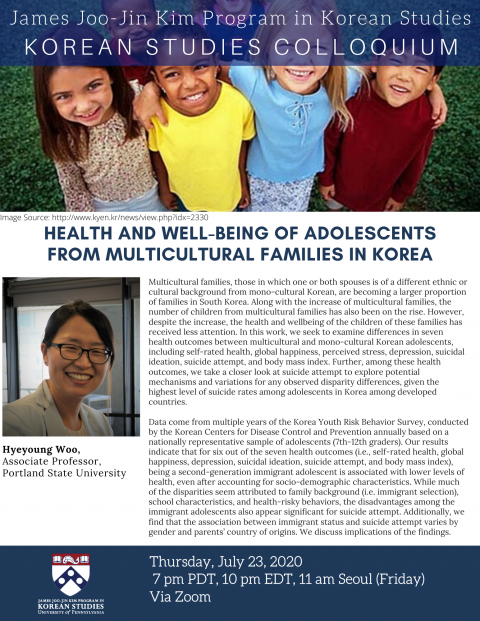
Korean Studies Colloquium
Via Zoom
7 pm PDT, 10 pm EDT, 11 am Seoul (Friday)
Reminder: the Zoom link for each talk will remain the same throughout the virtual series. If you would like to request the link, please email Seok Lee (kim-pks@sas.upenn.edu) with your name, affiliation, and email.
Multicultural families, those in which one or both spouses is of a different ethnic or cultural background from mono-cultural Korean, are becoming a larger proportion of families in South Korea. Along with the increase of multicultural families, the number of children from multicultural families has also been on the rise. However, despite the increase, the health and wellbeing of the children of these families has received less attention. In this work, we seek to examine differences in seven health outcomes between multicultural and mono-cultural Korean adolescents, including self-rated health, global happiness, perceived stress, depression, suicidal ideation, suicide attempt, and body mass index. Further, among these health outcomes, we take a closer look at suicide attempt to explore potential mechanisms and variations for any observed disparity differences, given the highest level of suicide rates among adolescents in Korea among developed countries.
Data come from multiple years of the Korea Youth Risk Behavior Survey, conducted by the Korean Centers for Disease Control and Prevention annually based on a nationally representative sample of adolescents (7th-12th graders). Our results indicate that for six out of the seven health outcomes (i.e., self-rated health, global happiness, depression, suicidal ideation, suicide attempt, and body mass index), being a second-generation immigrant adolescent is associated with lower levels of health, even after accounting for socio-demographic characteristics. While much of the disparities seem attributed to family background (i.e. immigrant selection), school characteristics, and health-risky behaviors, the disadvantages among the immigrant adolescents also appear significant for suicide attempt. Additionally, we find that the association between immigrant status and suicide attempt varies by gender and parents’ country of origins. We discuss implications of the findings.
 James Joo-Jin Kim Center for Korean Studies
James Joo-Jin Kim Center for Korean Studies